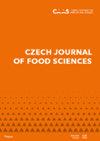紫茄子膳食纤维的提取及酶改性研究
IF 1
4区 农林科学
Q4 FOOD SCIENCE & TECHNOLOGY
引用次数: 0
摘要
:这项研究通过从紫茄子中提取膳食纤维,仔细研究了食品工业废物升级循环的机会。所面临的挑战之一是酶促褐变,这对从新鲜茄子中提取的纤维的质量产生了负面影响。评估了各种预处理程序,包括使用柠檬酸、亚硫酸盐浸渍、去皮和热处理,以确定其对提取率、颜色和所得膳食纤维功能的影响。研究结果表明,包括茄子去皮、亚硫酸盐溶液浸泡和随后的提取前蒸汽处理的预处理方法产生了最佳效果,提高了白度指数和持水能力。实验用添加纤维素酶、木聚糖酶和脂肪酶的传统酶进行酶提取。脂肪酶的加入显著提高了提取率和保水能力,尽管对膳食纤维有不希望的变黑作用。相反,木聚糖酶的应用成为最有效的处理方法,为衍生的膳食纤维提供最高的整体质量。本文章由计算机程序翻译,如有差异,请以英文原文为准。
Extraction and enzymatic modification of dietary fibre from purple aubergine
: This research scrutinised the opportunity of upcycling waste from the food industry by extracting dietary fibre from purple aubergine. One of the challenges addressed was enzymatic browning, which negatively influenced the quality of the fibre extracted from fresh aubergine. Various pre-treatment procedures were assessed, including using citric acid, sulphite immersion, peeling and thermal processing, to determine their effects on extraction yield, colour, and the functionality of the resultant dietary fibre. Findings indicated that a pre-treatment method involving aubergine peeling, sulphite solution immersion, and subsequent steaming before extraction produced optimal results, enhancing both whiteness index and water-holding capacity. Experiments were conducted with traditional enzymes supplemented with cellulase, xylanase, and lipase for enzymatic extraction. The addition of lipase notably elevated the extraction yield and water-holding capacity, albeit with an undesired darkening effect on the dietary fibre. In contrast, the application of xylanase emerged as the most effective treatment, delivering the highest overall quality for the derived dietary fibre.
求助全文
通过发布文献求助,成功后即可免费获取论文全文。
去求助
来源期刊

Czech Journal of Food Sciences
Food Science & Technology, Chemistry-食品科技
CiteScore
2.60
自引率
0.00%
发文量
48
审稿时长
7 months
期刊介绍:
Original research, critical review articles, and short communications dealing with food technology and processing (including food biochemistry, mikrobiology, analyse, engineering, nutrition and economy). Papers are published in English.
 求助内容:
求助内容: 应助结果提醒方式:
应助结果提醒方式:


